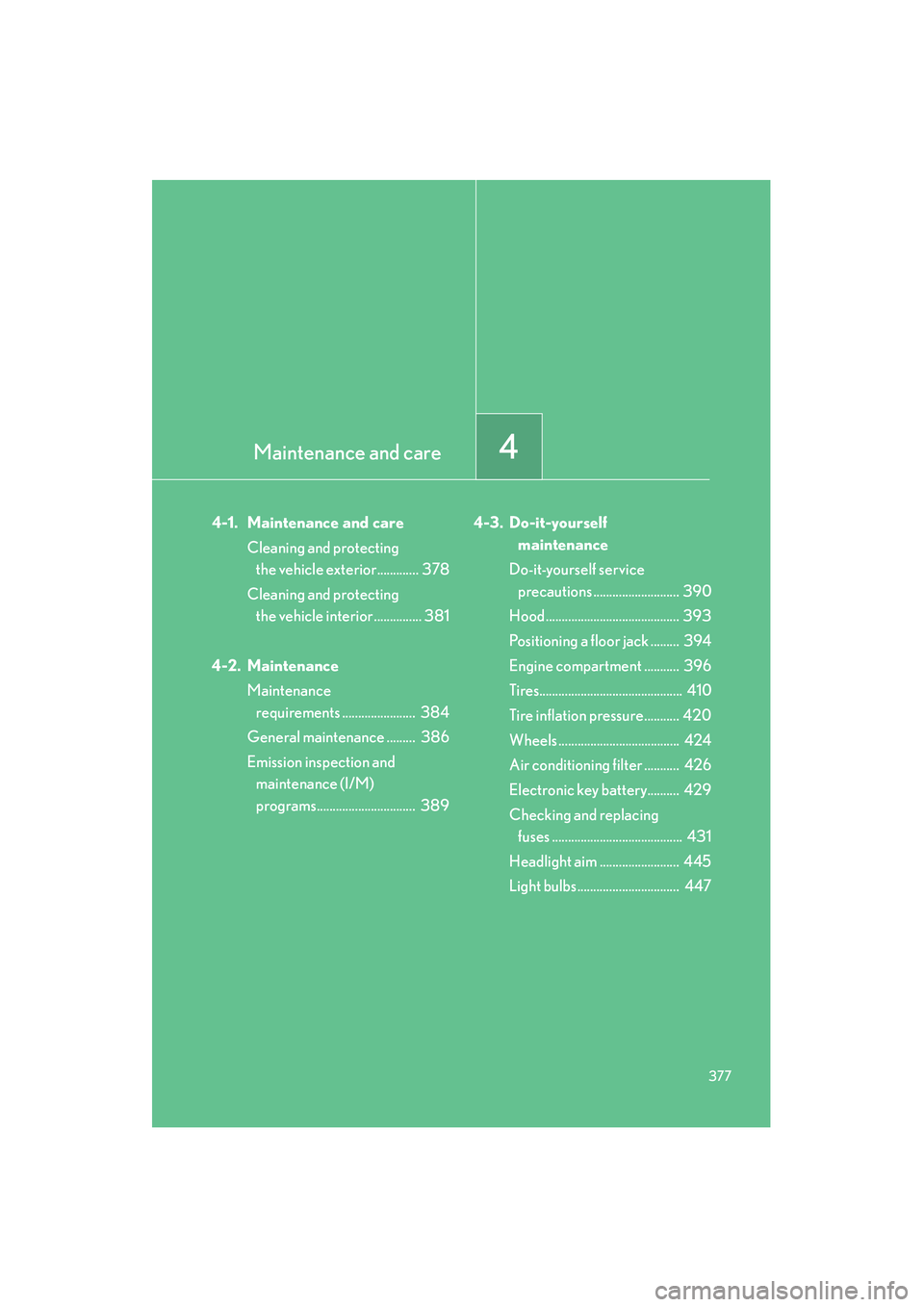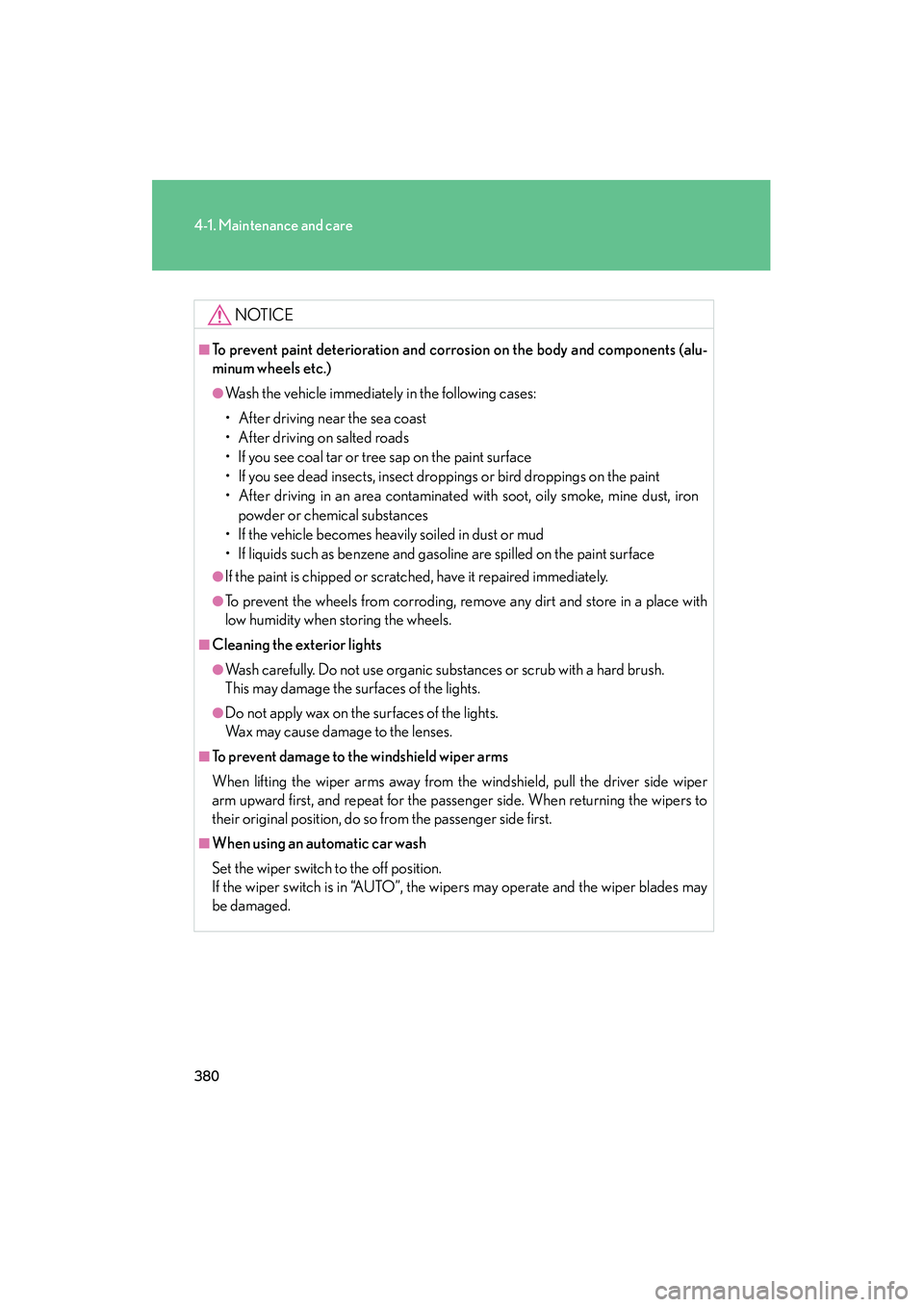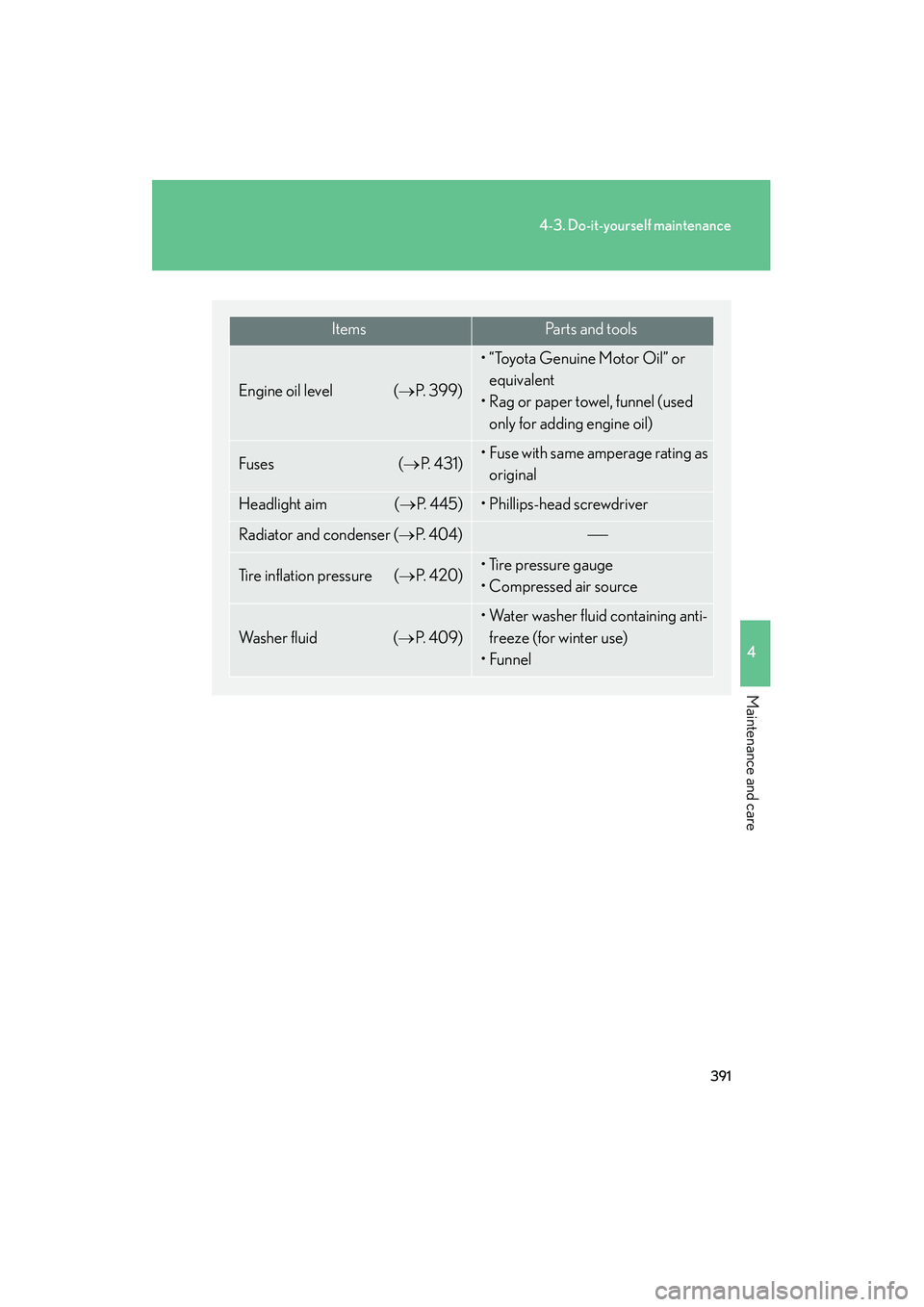light Lexus IS F 2012 Owners Manual
[x] Cancel search | Manufacturer: LEXUS, Model Year: 2012, Model line: IS F, Model: Lexus IS F 2012Pages: 578, PDF Size: 7.07 MB
Page 378 of 578

Maintenance and care4
377
IS F_U
4-1. Maintenance and careCleaning and protecting the vehicle exterior............. 378
Cleaning and protecting the vehicle interior ............... 381
4-2. Maintenance Maintenance requirements ....................... 384
General maintenance ......... 386
Emission inspection and maintenance (I/M)
programs............................... 389 4-3. Do-it-yourself
maintenance
Do-it-yourself service precautions ........................... 390
Hood .......................................... 393
Positioning a floor jack ......... 394
Engine compartment ........... 396
Tires............................................. 410
Tire inflation pressure........... 420
Wheels ...................................... 424
Air conditioning filter ........... 426
Electronic key battery.......... 429
Checking and replacing fuses ......................................... 431
Headlight aim ......................... 445
Light bulbs................................ 447
Page 381 of 578

380
4-1. Maintenance and care
IS F_U
NOTICE
■To prevent paint deterioration and corrosion on the body and components (alu-
minum wheels etc.)
●Wash the vehicle immediately in the following cases:
• After driving near the sea coast
• After driving on salted roads
• If you see coal tar or tree sap on the paint surface
• If you see dead insects, insect droppings or bird droppings on the paint
• After driving in an area contaminated with soot, oily smoke, mine dust, iron
powder or chemical substances
• If the vehicle becomes heavily soiled in dust or mud
• If liquids such as benzene and gasoline are spilled on the paint surface
●If the paint is chipped or scratched, have it repaired immediately.
●To prevent the wheels from corroding, remove any dirt and store in a place with
low humidity when storing the wheels.
■Cleaning the exterior lights
●Wash carefully. Do not use organic substances or scrub with a hard brush.
This may damage the surfaces of the lights.
●Do not apply wax on the surfaces of the lights.
Wax may cause damage to the lenses.
■To prevent damage to the windshield wiper arms
When lifting the wiper arms away from the windshield, pull the driver side wiper
arm upward first, and repeat for the passenger side. When returning the wipers to
their original position, do so from the passenger side first.
■When using an automatic car wash
Set the wiper switch to the off position.
If the wiper switch is in “AUTO”, the wipers may operate and the wiper blades may
be damaged.
Page 384 of 578

383
4-1. Maintenance and care
4
Maintenance and care
IS F_U
NOTICE
■Cleaning detergents
●Do not use organic substances such as benzene or gasoline, acidic or alkaline
solutions, dye, bleach or other detergent. Doing so may discolor the vehicle inte-
rior or cause streaks or damage to painted surfaces.
●Do not use polish wax or polish cleaner. The instrument panel's or other interior
part’s painted surface may be damaged.
■Preventing damage to leather surfaces
Observe the following precautions to avoid damage to and deterioration of leather
surfaces.
●Remove any dust or dirt on leather surfaces immediately.
●Do not expose the vehicle to direct sunlight for extended periods of time. Park
the vehicle in the shade, especially during summer.
●Do not place items made of vinyl, plastic, or that contain wax on the upholstery, as
they may stick to the leather surface if the vehicle interior heats up significantly.
■Water on the floor
Do not wash the vehicle floor with water.
Vehicle systems such as the audio system may be damaged if water comes into
contact with electrical components under the floor of the vehicle, and may also
cause the body to rust.
■Cleaning the inside of the rear window
●Do not use glass cleaner to clean the rear window, as this may cause damage to
the rear window defogger heater wires or antenna. Use a cloth dampened with
lukewarm water to gently wipe the window clean. Wipe the window in strokes
running parallel to the heater wires or antenna.
●Be careful not to scratch or damage the heater wires or antenna.
Page 388 of 578

387
4-2. Maintenance
4
Maintenance and care
IS F_U
Vehicle interior
ItemsCheck points
Accelerator pedal• Moves smoothly (without uneven pedal effort or catching)?
Automatic transmission “Park”
mechanism• Can the vehicle be held securely on an incline with the shift lever in
P?
Brake pedal
• Moves smoothly?
• Does it have appropriate clearance and correct amount of free play?
Brakes
• Not pull to one side when applied?
• Loss of brake effectiveness?
• Spongy feeling brake pedal?
• Pedal almost touches floor?
Head restraints• Move smoothly and lock securely?
Indicators/buzzers•Function properly?
Lights
• Do all the lights come on?
• Headlights aimed correctly? (→ P. 4 4 5 )
Pa r k i n g b r a ke
• Moves smoothly?
• Can hold the vehicle securely on
an incline?
Seat belts
• Does the seat belt system operate smoothly?
• Are the belts undamaged?
Seats• Do the seat controls operate prop- erly?
Page 392 of 578

391
4-3. Do-it-yourself maintenance
4
Maintenance and care
IS F_U
ItemsParts and tools
Engine oil level (→P. 399)
• “Toyota Genuine Motor Oil” or
equivalent
• Rag or paper towel, funnel (used
only for adding engine oil)
Fuses (→ P. 4 3 1 )• Fuse with same amperage rating as
original
Headlight aim ( →P. 4 4 5 )• Phillips-head screwdriver
Radiator and condenser ( →P. 404)
Tire inflation pressure ( →P. 4 2 0 )• Tire pressure gauge
• Compressed air source
Wa s h e r f l u i d ( →P. 4 0 9 )
• Water washer fluid containing anti-
freeze (for winter use)
•Funnel
Page 394 of 578

393
4-3. Do-it-yourself maintenance
4
Maintenance and care
IS F_U
Hood
CAUTION
■Pre-driving check
Check that the hood is fully closed and locked.
If the hood is not locked properly it may open while the vehicle is in motion and
cause an accident, which may result in death or serious injury.
Release the lock from the inside of the vehicle to open the hood.
Pull the hood release lever.
The hood will pop up slightly.
Lift the auxiliary catch lever and
lift the hood.
STEP1
STEP2
Page 406 of 578

405
4-3. Do-it-yourself maintenance
4
Maintenance and care
IS F_U■
Adding fluid
Make sure to check the fluid type and prepare the necessary items.
Fluid typeFMVSS No.116 DOT 3 or SAE J1703 brake fluid
ItemsClean funnel
■Brake fluid can absorb moisture from the air
Excess moisture in the fluid can cause a dangerous loss of braking efficiency. Use
only newly opened brake fluid.
CAUTION
■When filling the reservoir
Take care because brake fluid can harm your hands or eyes and damage painted
surfaces.
If fluid gets on your hands or in your eyes, flush the affected area with clean water
immediately.
If you still experience discomfort, see a doctor.
NOTICE
■If the fluid level is low or high
It is normal for the brake fluid level to go down slightly as the brake pads wear or
when the fluid level in the accumulator is high.
If the reservoir needs frequent refilling, it may indicate a serious problem.
Page 409 of 578

408
4-3. Do-it-yourself maintenance
IS F_U
CAUTION
■Chemicals in the battery
A battery contains poisonous and corrosive sulfuric acid and may produce hydro-
gen gas which is flammable and explosive. To reduce the risk of death or serious
injury, take the following precautions while working on or near the battery:
●Do not cause sparks by touching the battery terminals with tools.
●Do not smoke or light a match near the battery.
●Avoid contact with eyes, skin and clothes.
●Never inhale or swallow electrolyte.
●Wear protective safety glasses when working near the battery.
●Keep children away from the battery.
■Where to safely charge the battery
Always charge the battery in an open area. Do not charge the battery in a garage or
closed room where there is not sufficient ventilation.
■How to recharge the battery
Only perform a slow charge (5 A or less). The battery may explode if charged at a
quicker rate.
■Emergency measures regarding electrolyte
●If electrolyte gets in your eyes
Flush your eyes with clean water for at least 15 minutes and get immediate medi-
cal attention. If possible, continue to apply water with a sponge or cloth while
traveling to the nearest medical facility.
●If electrolyte gets on your skin
Wash the affected area thoroughly. If you feel pain or burning, get medical atten-
tion immediately.
●If electrolyte gets on your clothes
It can soak through clothing on to your skin. Immediately take off the clothing and
follow the procedure above if necessary.
●If you accidentally swallow electrolyte
Drink a large quantity of water or milk. Get emergency medical attention imme-
diately.
Page 413 of 578

412
4-3. Do-it-yourself maintenance
IS F_UThe tire inflation pressure initial-
ization setting display
Continue to press “<” or “>” until
the initialization setting display
appears.
It may take several minutes to com-
plete the setting. Wait for several
minutes before turning the
“ENGINE START STOP” switch to
OFF if necessary.
Recording tire inflation pressure
settings
Press and hold the “ON/OFF” but-
ton until the tire pressure warning
light blinks slowly 3 times to indi-
cate that the initial setting is com-
plete.
Wait for a few minutes with the IGNITION ON mode, and then
turn the “ENGINE START STOP” switch to OFF.
STEP4
STEP5
Page 415 of 578

414
4-3. Do-it-yourself maintenance
IS F_U■
Selecting ID codes
When replacing tires, make sure to select the ID code set that matches
the new tire set. If the ID code is set to the wrong tire setting, the tire
pressure warning system will not operate properly. After driving for
about 20 minutes, the tire pressure warning light comes on after blink-
ing for 1 minute to indicate a system malfunction.
Tire pressure warning valve and
transmitter ID code settings dis-
play
Press “<” or “>” repeatedly until
the setting display appears.
Switching ID codes
Press the “ON/OFF” button to
switch between “MAIN” and
“2ND” ID codes.